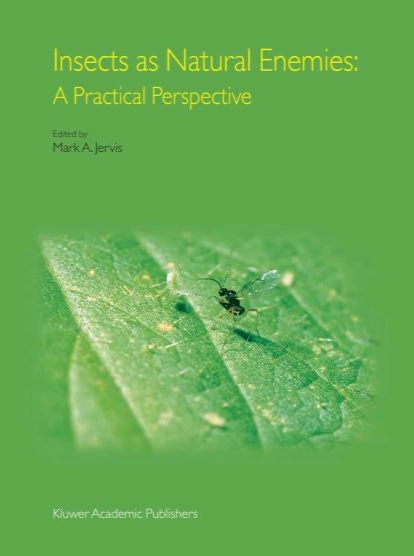Insects as a natural enemies : a practical perspective
- نوع فایل : کتاب
- زبان : انگلیسی
- مؤلف : Mark A Jervis
- ناشر : Dordrecht : Springer, cop.
- چاپ و سال / کشور: 2005
- شابک / ISBN : 9781402017346
Description
1 Foraging Behaviour M.D.E. Fellowes, J.J.M. van Alphen and M.A. Jervis 1.1 Behaviour of insect parasitoids and predators 1 1.2 Methodology 2 1.3 The treatment of parasitoids prior to their use in experiments 8 1.4 Handling behavioural data 10 1.5 Host/prey location behaviour 11 1.6 Clutch size 34 1.7 Host-feeding 37 1.8 Host discrimination 38 1.9 Sex allocation 45 1.10 Functional responses 49 1.11 Switching behaviour 54 1.12 Patch time allocation 56 1.13 Patch defence behaviour 60 1.14 Distribution of parasitoids over a host population 61 1.15 Measuring encounter rates 65 1.16 Life-history traits and foraging behaviour 66 1.17 The cost of reproduction 67 1.18 Age-dependent foraging decisions 67 1.19 Foraging behaviour and taxonomy 68 1.20 Foraging behaviour and host resistance 68 1.21 Insect natural enemy foraging behaviour and community ecology 69 1.22 Concluding remarks 70 1.23 Acknowledgements 71 2 The Life-cycle M.A. Jervis, M.J.W. Copland and J.A. Harvey 2.1 Introduction 73 2.2 Anatomical studies on natural enemies 73 2.3 Female reproductive organs 77 2.4 Male reproductive system 92 2.5 Sex ratio 92 2.6 Locating eggs in hosts 93 2.7 Fecundity 94 2.8 Adult longevity 108 2.9 Growth and development of immatures 114 2.10 Survival of immatures 140 2.11 Intrinsic rate of natural increase 154 2.12 Dormancy 159 2.13 Investigating physiological resource allocation and dynamics 162 2.14 Tracking resources 164 2.15 Acknowledgements 165 3 Genetics L.W. Beukeboom and B.J. Zwaan 3.1 Introduction 167 3.2 Genetic markers and maps 167 3.3 Genetics of reproductive mode 185 3.4 Genetics of sex determination and sex ratio 190 3.5 Quantitative genetics 201 4 Mating Behaviour I.C.W. Hardy, P.J. Ode and M.T. Siva-Jothy 4.1 Introduction 219 4.2 General methodology 222 4.3 Pair formation and courtship 227 4.4 Copulation and insemination 244 4.5 Post-mating events 249 4.6 Comparative studies of mating behaviour 257 4.7 Conclusion 260 4.8 Acknowledgements 260 5 Mating Systems I.C.W. Hardy, P.J. Ode and M.T. Siva-Jothy 5.1 Introduction 261 5.2 Mating systems theory 261 5.3 Methods of studying mating systems 264 5.4 Unravelling parasitoid mating systems 271 5.5 Predator mating systems 292 5.6 Conclusions 297 5.7 Acknowledgements 298 6 Populations and Communities K.D. Sunderland, W. Powell and W.O.C. Symondson 6.1 Introduction 299 6.2 Field sampling techniques 301 viii Contents 6.3 Determining trophic relationships 366 6.4 Genetic variability in field populations of natural enemies 417 6.5 Wolbachia bacteria (and other intracellular symbionts) and parasitoids and predators (by R.D.J. Butcher and M.A. Jervis) 419 6.6 Acknowledgements 434 7 Population Dynamics N.A.C. Kidd and M.A. Jervis 7.1 Introduction 435 7.2 Demonstrating and quantifying predation and parasitism 435 7.3 The role of natural enemies in insect population dynamics 455 7.4 Selection criteria in classical biological control 504 7.6 Acknowledgements 523 8 Phytophagy M.A. Jervis and G.E. Heimpel 8.1 Introduction 525 8.2 What plant materials do natural enemies feed upon, and from what sources? 527 8.3 Do natural enemies show specificity in the plant food sources they exploit? 532 8.4 Interpreting patterns of resource utilisation 535 8.5 Insect preferences and foraging energetics 536 8.6 Pest management through the provision of plant-derived foods: a directed approach 541 8.7 Natural enemies as pollinators, and the use of flower visitation webs 548 8.8 Acknowledgements 550 References 551 Author Index 687 Genus and Species Index


